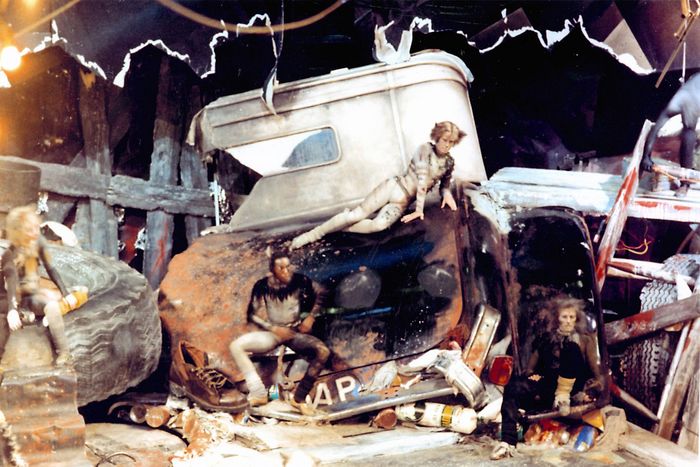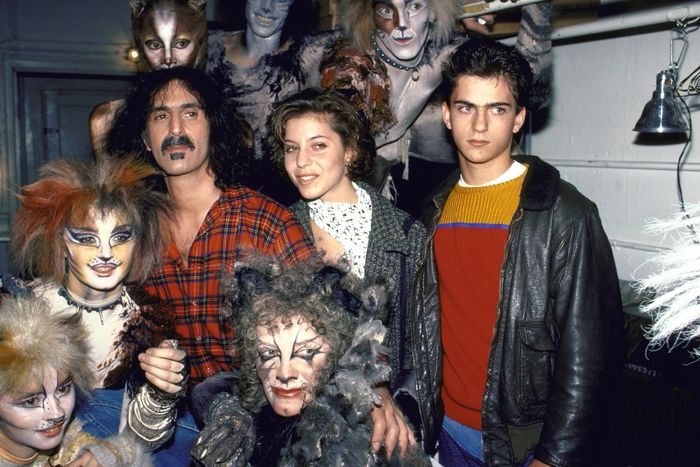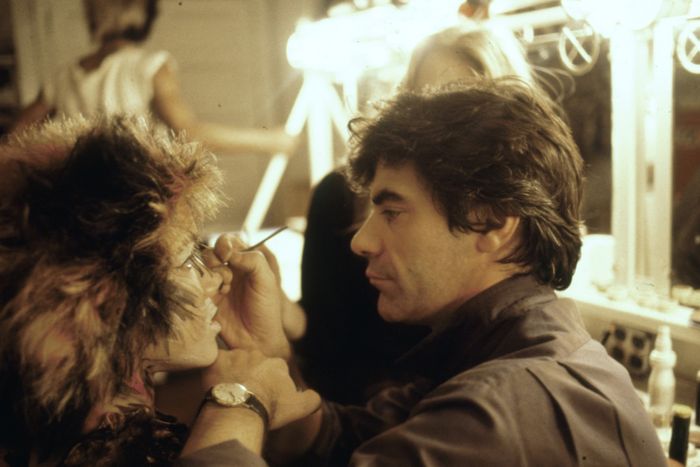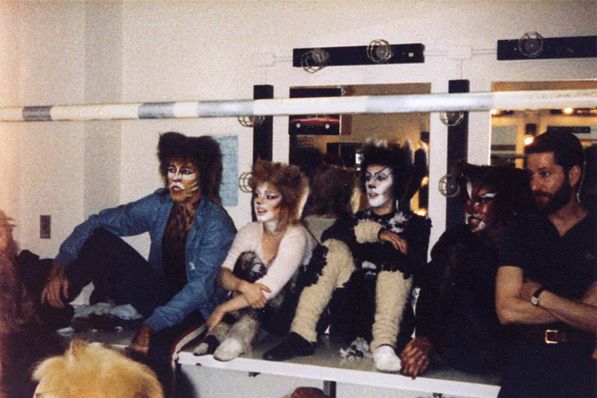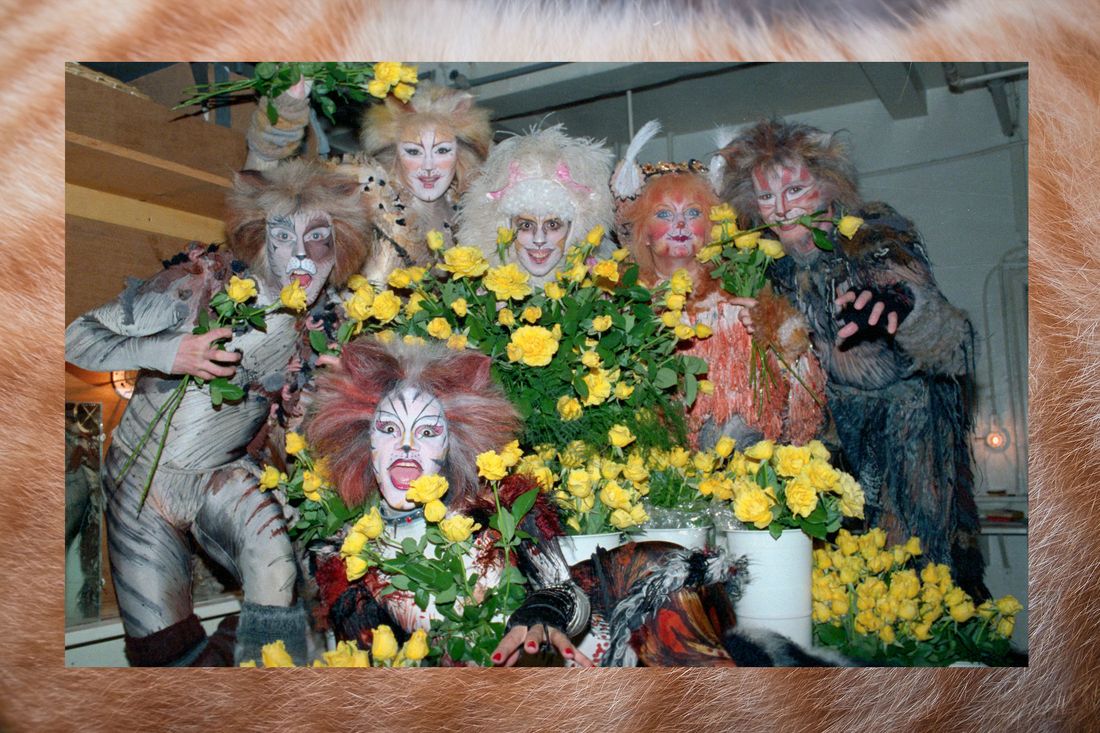
Cats opened in London in May of 1981, and by the time the New York show began previews at the Winter Garden Theatre in the fall of 1982, it had already become the Broadway event of the season. Composed by Andrew Lloyd Webber, with lyrics drawn from T. S. Eliot poems, the plot is famously thin: The musical follows a tribe of cats (the Jellicles) who meet up for an annual event (the Jellicle Ball), at which one is chosen to ascend to the “Heaviside Layer” (heaven, basically) and be reborn. But something about the combination of music, dancing, set, and costumes elevated it into an experience that, for many at least, was transcendent. It continued to draw audiences over 38 years, dozens of productions around the world, and now, one star-studded film adaptation.
But for the performers involved, the first few years of the production — before it became a “Broadway product” — carried an energy that was unrepeatable. When it debuted, it felt edgy and immersive, with a punkish twist. In interviews with 11 members of the original cast, as well as a handful of key crew and creative team members, they shared vivid memories of those early days, from the parade of celebrities who came backstage (including Andy Warhol) to some of the unique challenges the show presented (the performers sweat so much, the microphone transmitters had to be sheathed in condoms). They also spoke about the devastating impact of AIDS on the cast, and the odd dissonance of being in an enormously successful show, yet practically anonymous outside the theater. “We were literally the talk of the town,” said Kenneth Ard, who played Plato, Macavity, and Rumpus Cat. “Of course, after a couple years it became this joke. But it was the most spectacular thing of its time.”
Auditions: ‘My Body Was Perfect, Everything Was Perfect’
Not long after the London show opened, the New York Times declared that, in Britain, tickets were “surpassed in demand only by invitations to the royal wedding” of Prince Charles and Lady Diana that summer. Within a few months, the London-based creative team — choreographer Gillian Lynne, director Trevor Nunn, and Webber — were traveling to New York to begin auditions for the Broadway show.
Kenneth Ard (Plato, Macavity, and Rumpus Cat): Everyone was talking about this new musical, Cats. My friend had just convinced me to come to NY. I had this slinky, lithe body and felt very feline. I was 21, my body was perfect, everything was perfect for what was happening in NY in the early ’80s.
Herman Sebek (Pouncival): I was in the West Side Story tour of Italy and Paris, and when it wrapped, a few cast members said they were going to go to London to see a new show. I thought it was Katz, like the deli. The minute I landed back in the States I opened up Backstage’s audition papers and there it was: Cats USA, the first open call.
Steven Hack (Understudy): The general hubbub was that they wanted people who were extremely strong dancers who could also sing and act. Some people had agents who arranged auditions, but the rest of us went to the open call. It was difficult because Gillian Lynne had made the dancing like cat movements. I saw excellent dancers who couldn’t get it.
Sebek: I wore this tight turquoise button-up T-shirt that was almost cropped and a skin-colored unitard I’d rolled down to my waist, only to discover Gillian, who was 50-something, in see-through hose with a thong. When my group went up she pointed at me and said, “You! Thank you, everyone else.”
Robert Hoshour (Tumblebrutus): The audition process went on and on because Gillian Lynn, Trevor Nunn, and Andrew Lloyd Webber would all come over for a [few weeks] and audition people and then they’d go away for months.
Ard: It got down to last couple guys and then it was like, “Who has tricks?” I did a roundoff, back handspring, back layout, and landed in the splits. Nobody else had tricks. So they gave me a callback.
Whitney Kershaw (Sillabub): I was at the dentist getting my wisdom teeth pulled and they had just given me a relaxant when I got a phone call. My agent said, “You’re going to be one of the principal people in Cats!” When I woke up, I told my husband, “I dreamed I got Cats.”
Ken Page (Old Deuteronomy): The weekend before they’d be announcing the cast, I went to visit friends on Fire Island. I’m walking down the beach and a guy is walking toward me with two Siamese cats on leashes. I was with my friend Reed Jones, who went on to play Skimbleshanks. Anyway, the cats walked around me three times. Reed and I looked at each other, because we were both waiting to hear about Cats. Monday morning, as I walked in my door, the phone was ringing and it was the production office, asking if I wanted to play Old Deuteronomy. Well, that’s like asking someone, would you like $49 million? I said, “Oh my God, yes.”
Page: They were saying Cher was going to play Grizabella. All kinds of names were being thrown around. After [the cast was announced], I went to visit a friend who’d gone up for Grizabella. She said, “Congratulations, but I have one question: Who the hell is Betty Buckley?” I said, “Well, she’s Grizabella!” I think that Betty and I getting cast surprised the theater community because we weren’t the people anyone was talking about.
Sebek: I was a pretty cocky kid back then. Then I went in to the first rehearsal and saw Hector Mercado, star of Alvin Ailey, and Betty Buckley, star of TV and stage. I was starstruck.
Betty Buckley (Grizabella): When I had my callback, Trevor Nunn directed me to sing “Memory” three times. He kept saying, “More suicidal.”
Rehearsals: ‘I Jumped When I Saw a Dog’
Rehearsals for Cats began in August of 1982 and ran for almost two months. The cast spent the first days practicing theater exercises meant to help them learn to not just act like cats but to feel, truly, that they were cats. (Buckley got through one such exercise by deciding to channel a sleepy cat, curling up in a sunny spot by a window and taking a nap.) Meanwhile, a separate team began transforming the Winter Garden Theatre into a space that could accommodate Napier’s complex set. There was a tattered billboard, an old car, and a baby buggy, as well as hundreds of props, all of which were oversize. When the performers got to the theater, they tried to learn where everything was so they wouldn’t hurt themselves.
Hoshour: The rehearsal period was unusual in that, at first, we’d come in and do these sense-memory exercises.
Ard: We basically crawled around and pretended to be cats.
Hack: After about a week, one gal wasn’t having it. She left the show and was replaced by Marlene Danielle, who ended up being in it for 18 years.
David Taylor (Production Stage Manager): As Trevor suggested, if you’re not a cat person, if you’ve never had a cat or you’re allergic to cats, you still you need to study them.
Hoshour: I did have a cat. He was very, let’s say, temperamental. He would crawl up on the shelf where my wife and I kept our glasses, knock one down, and if you did not come out and scream at him, he’d knock the next one down.
Anna McNeely (Jennyanydots): Trevor’s thing was that we feel organically that we were cats. He didn’t want us hissing or meowing. He wanted it to be coming from deep inside.
Donna King (Bombalurina): I got so into character. I was eating lots of sushi and one day I was walking down in the East Village and I jumped when I saw a dog.
Hoshour: Gillian’s choreography was a lot tougher than it looked and my background was not dance, per se. I was an acrobat. I remember sitting in the studio watching all these phenomenal performers, thinking, “I don’t know if I belong, but it sure feels good to be here.”
Page: At one point I was doing a lot of dancing in the opening sequence. But as things went along, Gillian said, “Darling, we’re going to take you out of the opening.” I said, “Oh no! I wanted to prove I can dance.” She said, “You’re doing very good, darling, but we want you to just lord over the tribe.” I think it was a nice way of saying I wasn’t quite up to the level of the other people.
Hack: During rehearsals, Willie Rosario, who’d been cast as Skimbleshanks, hurt his knee really badly.
Hoshour: In the middle of one rehearsal for the Jellicle Ball, Willie went down. There was a scream, and everything in the room stopped. They took him away to the hospital and we were all just sitting there thinking, that could have been any of us. The creative team put in his understudy, Reed Jones, and he became Skimbleshanks. If nothing else, that’ll tighten a cast really quick.
Hack: When we got to the theater for the first time we finally saw the actual things they’d been building for weeks. The most difficult thing is we were on a raked stage, meaning it was tilted. There was every opportunity to hurt yourself.
John Napier (set and costume designer): I’d come over to NY to look for spaces we could put the show. I looked at the Armory and old warehouses. But it’s a Broadway musical, and the Shuberts had a theater. So I used the theater.
Taylor: The Shuberts had just renovated the Winter Garden when John came in and said, “We’re going to rip the shit out of this.”
Napier: I wasn’t interested in doing the show in a proscenium theater with gilding and gold. I needed mystery. The Shuberts constantly told me how much it was costing them. I said, “Well, we’ll find out whether you’ll get your money back!”
Ray Huessy (set design assistant): We painted the entire theater black. We cut a six-foot square hole in the decorative plaster ceiling for Grizabella’s exit to the Heaviside Layer. Most Broadway theaters also have an asbestos curtain that can separate the stage from the audience in case of fire. But we were building the stage out into the house, [so] that wasn’t going to happen. We had to have a fireman at every performance.
Napier: I had been on a journey to visit some relations, going along this rather derelict part of London, when I saw this old billboard tipped over. You have those moments where you go, ding! It made perfect sense for it to be in a kind of wasteland. It’s a complex set, but it’s a simple set. You’re in one place.
Huessy: It all boils down to one brilliant idea, and that is to make everything around the cats three times life-size. The car trunk opened up and people crawled out, the oven opened up and dancers ran out. And of course, in the second act, the back wall folded down and covered the stage, so you had a whole different set of scenery. But that’s John Napier. He’s a bit of a madman but also a genius. If he hadn’t come up with this concept, the show could have been kind of embarrassing — the British say twee.
Hoshour: What Trevor Nunn said was that he’d gone to Disney World and saw that people were putting down good money to be transported into a different universe. That’s what he and John Napier wanted to create.
Ard: During rehearsals, there’d be reporters outside, taking pictures. It was maddening, and of course exciting because I felt like I’d finally arrived.
McNeely: They were very, very careful at the beginning. They didn’t show any pictures out front — just two eyes and “Cats.”
Showtime: ‘We Were Killing Our Bodies to Do This Crazy Job’
Opening night was attended by everyone from Barbara Walters to Mikhail Baryshnikov. Cats’ popularity wasn’t due to the reviews (“It’s quite a musical, but hardly purr-fect,” quipped the New York Post); it grew legendary through word-of-mouth. During the show, performers popped out of holes at audience members’ feet, they jumped in people’s laps, they crawled along banisters. All of this came with challenges. How do you keep a full face of makeup from smearing when you’re dancing so hard you’re perspiring pounds of sweat? How do you maintain your body in order to perform such athletic feats month after month? What do you do when you start slipping off the balcony in the middle of the show?
Hoshour: There was like nothing like that opening night. Purina Cat Chow gave us each a bucket with a bottle of Champagne in it. [They] lined the staircase going up to the dressing rooms.
Harry Groener (Munkustrap): I’d never heard screaming like that from an audience. The sound was so intense it pushed tears out of our eyes.
Page: The opening night party was at the Waldorf. It was super star-studded. It was hard to stay in the moment because the moment was so big.
King: My mother came from Kansas. She watched Jessica Lange, Baryshnikov, Mary Tyler Moore, and Andy Warhol go in. Later, the Factory rang me backstage and asked if I’d like to do a shoot. Andy [Warhol] picked me up in a limo and we drove out to a studio in Queens.
Groener: Jimmy Carter and his wife came. Robert Redford brought his kids. Gregory Peck led a standing ovation. It went on for days — he was so tall.
Taylor: We brought Cary Grant to this little room we had backstage so he wouldn’t get mobbed in intermission, but of course then the whole cast heard so suddenly you had 22 cats jammed into that room. He was so gracious.
King: He said, “Back in my day you all would have been stars.”
Sebek: The most magical for me was Michael Jackson. He came backstage and as he was leaving, he said to me, “I like your spins!” Then we went over to the window. They’d pulled his limo up to the stage door. There were all these people running from all the streets, like ants, to see him.
King: Frank Zappa watched the show then took me out dancing to Studio 54.
Hack: Some people loved it and some didn’t. Some of my friends made fun of it. One said we looked like monkeys. He was a dog person. People who had cats were more fond of the show than dog people because the show had a lot of digs at dogs.
Terrence Mann (Rum Tum Tugger): They had $6 million in box-office advance sales. Everyone knew it was going to be running at least a couple years.
Hoshour: It was a double-edged sword because as a performer, prior to Cats, you got a job and knew it was only for a few months. But then they slapped on that slogan “Cats: Now and Forever.”
Hack: The marketing team made that up and used that in place of a reviewer’s quote. Forever!
Nancy Coyne (advertising): Usually, you’d put a reviewer’s quote on the marquee. But Cats didn’t get a great review from Frank Rich at the New York Times, which was the only review that mattered. I said it didn’t need a headline, but Bernie Jacobs, the president of the Shubert Organization, wanted one. I said, how about “Now and Forever”? He said, “That’s it” and walked out. It stuck!
Taylor: I told the producers, “Now you’ve got your hit, but this is a strenuous show.” We only had four understudies and I said, “We need at least eight.” They said, “If that’s what it takes.” Still, there were nights we ran out of understudies.
Hack: I understudied for four roles. In rehearsals one day I sat in the corner about to cry, because it was so overwhelming that you had to learn all of them at the same time. And I went on for all those characters many times. It was a dangerous show because not only was the set difficult to navigate but the choreography was really hard. Plus you were crawling on your hands and knees, which humans are not meant to do.
Sebek: I developed a stress fracture in my spine at 22 that totally changed my career. Fortunately, I had a voice and could act. We all knew we were killing our bodies to do this crazy job of a show.
Hack: A few times someone hurt themselves and I’d have to be ready to go on in ten minutes or less. There was a lot of putting on makeup fast. Sometimes the understudy’s warmup was just running down four flights of stairs.
Groener: Initially during tech, John Napier would put your makeup on and then you’d have to duplicate it. When he got to me, he went nuts and made my makeup so elaborate that putting it on took forever.
Sebek: We all got jealous when we learned the La Cage [aux Folles] girls were getting paid extra for showing up early to do their makeup. We were like, “Hey! Our makeup is just as complicated!”
Napier: My intention was to make human beings be cat-like. I didn’t want it to be overt.
Hack: John would come back and smear people’s makeup. He’d say, “You’re not supposed to be pretty! You’re supposed to be messy, like cats.”
Kershaw: I made my cat more feminine. She definitely had pink lips and was a little more dolled up.
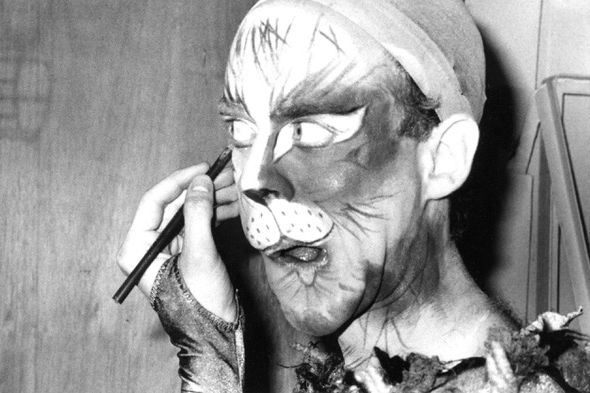
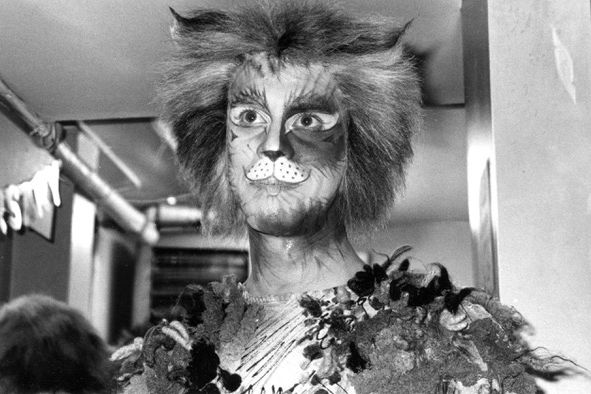
Groener: The wigs were made from yak hair— that gave it the look John wanted.
Hack: We also had to figure how to get makeup to stick even though we were sweating so much. At the beginning we’d spray this adhesive glue on our faces. It was probably very unhealthy.
Ard: You have a body suit on and you’d be soaking wet. So you’re basically naked.
Martin Levan (sound designer): [Sound was also] tricky. Bits of the sound desk weren’t working, so we dismantled it and found that mice had eaten through some of the cables. You’d think the cats would have kept them away, wouldn’t you! It was also reasonably early days for having radio mics on dancers, and the way they worked was you’d run a cable from the microphone to a transmitter. But sweat would get in the connectors of the transmitter, so we put the transmitters in condoms.
Taylor: We needed one for every mic pack every show, so we were going through them. I was not tasked with having to be embarrassed by going into Duane Reade every day and saying, “Let me have [more] extra large condoms.”
Huessy: The radio mic were constantly dying, so sometimes they’d take a working mic off one of the dancers and give it to one of the principles.
Buckley: On press night, when all the major critics would be there, I was waiting for my entrance as Grizabella when my body mic went out. I was literally trembling in the wings as they changed my mic then zipped me back into my costume. A moment later it turns out that mic’s broken, too. They replace it, and now this is split-seconds before I’m supposed to enter. That mic wasn’t working either. [Assistant property man] Merlyn Davis says, “Charge up front to the foot mics and sing like you did when you were 12.” [One reviewer] said my voice was strident. I thought, Your voice would be strident too if you were singing off-mic in the Winter Garden Theatre! It was hilarious. In retrospect.
Kershaw: At the opening of the second act, all the cats are lying onstage and one kitten — that’s me — jumps up and starts singing “Memory.” One night, I couldn’t think of my words! I started going, “la la, la la la.”
Huessy: Betty Buckley came out one night during previews and when she sang “Memory” she peeled the scenery off the walls. Her performance made my hair stand on end.
Hack: After the opening number, all the characters I played climbed up the box seats to the balcony along this little ramp. Before the show there was an announcement asking people not to put things on it, but we’d still have to climb over coats and drinks and programs. We had a game where, if we saw a drink on the rail, we’d knock it into [the audience member’s] lap. We could really have hurt ourselves, especially if we’d fallen off that balcony rail into the orchestra section.
Sebek: One of my castmates fell into the lap of Phil Donahue.
Kershaw: I was afraid of heights and as I was crawling across that railing I started slipping, so I slipped toward the balcony instead of down into the orchestra. I looked up and was like, I’m in Phil Donahue’s lap! He just smiled.
Mann: As Rum Tug Tugger, at one point I’d bring somebody up onstage and dance with them. One night I saw Bob Fosse in the audience wearing this powder-blue jacket. I stopped right in front of him and started to grab his hands. He said, “Don’t you fucking touch me.” I said, “Yes sir, I’m a big fan.”
Kershaw: [Cast members would sometimes] say, “Oh my God, that guy in the audience was so cute. I jumped on his lap.”
Ard: As we went through the audience, sometimes dancers would slip someone their number. Or vice versa. I did it once.
Sebek: There were these tubes that went from the basement into the audience that I’d crawl out of. One night this audience member saw me and said, “Oh, what a cute kitty.” And she grabbed my face and kissed me right on the lips! Sometimes audience members would get up onstage to chase a cat. They didn’t always realize the fourth wall.
Hack: There were a few people who came to the show hundreds of times. One was a lady who had a huge irrational crush on Herman Sebek. Another was this guy I ran into one night on the street. He yelled out, “It’s Steven Hack from Cats!” I thought, “Oh no.” Because any normal person would not have recognized me.
Backstage: ‘This Freaking Show Sucks!’
Even as the show became a runaway success, the performers’ transformation into cats was so complete that, out of their makeup and costumes, they remained anonymous. Certain cast members remember it contributing to offstage drama. But most recalled the company as relatively tight. For months, if not years, they prepared together, performed together, and partied together. The original cast had also just begun to leave the company as the AIDS virus began spreading. Four original cast members — Rene Clemente, Steven Gelfer, Timothy Scott, and Reed Jones — died in the early years of the production.
Hack: It was very disconcerting to paint your face every day, work your ass off, and then walk out the stage door and have people say, “Were you in the show?”
Ard: There would be times when I’d leave and I couldn’t get a cab. It would be maddening. They’d pass by and pick up somebody else down the street.
Hoshour: My mom had no idea which one of the cats I was. My wife only knew me because she recognized my butt. I was just thrilled to be there. But it didn’t work well with a lot of egos. And some egos had to find other ways to get their strokes. Some of the backstage got to be a little tough.
Page: I’d done three big shows before so people kind of knew me from those. But it was very humbling. You were part of this enormous event and yet what audiences saw in Cats was just the characters.
Kershaw: We got to do cool things. We did the I Love NY commercials. I did a Working Woman’s spread. And the night of the Tony awards was incredibly exciting. All those Tonys! After the show, the entire cast, still in costume, went leaping grande jettes down the street.
Taylor: It was one of the happier companies. Mind you, it helps to be doing a hit.
Kershaw: For those of us who were young, we were so innocent and not jaded. In winter, Christine [Langner] and I built a beautiful snowman right outside the theater.
McNeely: We’d go out together. That was in the Caramba! Days.
New York Times, 1983: The Tex-Mex restaurant Caramba! opened on Eighth Avenue, between 54th and 55th Streets, in 1980, and it has been mobbed ever since.
Kershaw: We’d get dinner, have a margarita, decompress.
Hector Mercado (Alonzo): We found out later the margaritas were not made with tequila but with grain alcohol. Killer stuff.
King: I ended up marrying John Napier. We were married for ten years.
Page: In any show, you get to a point where it’s like a family backstage, especially in a long run — you have disagreements, you have loves.
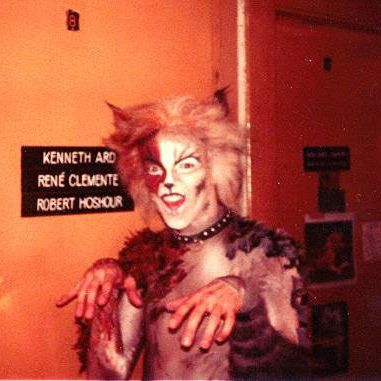
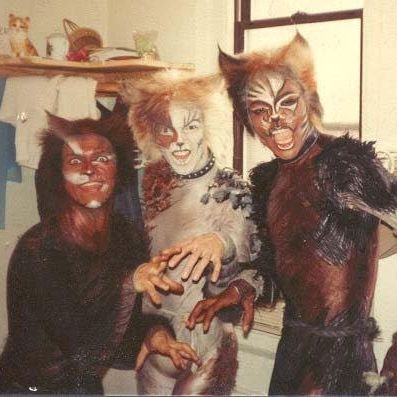
King: The dressing rooms were a trip. Everyone was very eccentric.
Sebek: Most of the young dancing boys were put in a room. The older dancing cats were put in another room. And the gymnastic-y guys were in another room. Everybody had their little posse. Then the girls had their own dressing room, and little gay boy me, I’d often hang out with them, gabbing while everyone’s getting ready. One night I’m in there and, knock knock knock, it’s the straight older cats. The girls are like, “Get out of here!” They’re like, “But Herman’s in there!” And the girls were like, “It’s Herman! It’s the little gay brother.”
Groener: When Terry Mann, Hector Mercado, and I first walked into the tiny dressing room we’d be sharing, we thought, oh man, this is going to be a problem. It did not turn out to be one at all. We had a tape player — we’d play Thriller — and we had a small ice chest. Because beer tasted so good at the end of the show.
Ard: We had the best time in our dressing room, but Terrence Mann was down the hall and we were always getting shushed by him because of course he was trying to concentrate. He wanted to sleep or something.
Mann: Yelling out the door telling someone to shut the fuck up — I can remember that. But it wasn’t like I was an older statesman who needed his rest.
King: I was in a dressing room with four divas, including Rene Ceballos, who’s no longer with us [she died in 2016]. She’d come off from the 12-minute Jellicle Ball and there’d always be something she’d have a major fit about.
Ard: That Jellicle Ball was incredibly difficult. You dance and dance and dance and then you have to stop and sing.
King: One time Rene [Ceballos] went outside during intermission and started screaming, “I hate this fucking show, this freaking show sucks!” This producer was like, “Rene, go inside.” Rene used to come on the subway with her full makeup on.
Hack: AIDS soon started rearing its horrible ugly head. We lost a bunch of castmates to that plague.
Mercado: One got sick and then another. They would come in after taking a week off and do a show or two. Then you’d walk in to find out the understudy was in again.
Hoshour: Gay, straight, I don’t care what you were, we’re all out there sweating together and no one knew what was causing this thing. There was so much fear.
Page: These are people burned in your memory as being so alive and electric. There are no words to bring into focus how many people were dying and how quickly. It was devastating.
Hoshour: A few years later I took my daughter to see the show. It was one of the hardest things I’ve ever done. Everyone had been so unrecognizable under their costumes that it was like [watching] ghosts dance on and off the stage. I’d see Tim Scott, Reed Jones, dancing through, and then have to remind myself, no, they’re gone. As far as the whole history of Cats in that period, AIDS will be the thing that I’ll remember.
Hack: It made us feel that we better stay, keep our job, because we might never get one again. Also, that these are our family members, and we wanted to stay with our family.
Page: I did the show about two years, and then as the original cast began to leave, it started to turn into, and I say with as much respect as possible, a Broadway product as opposed to that innovative gem we’d discovered.
Hoshour: It’s hard to leave a good contract, but it was very wearing on the body. I went to see it later and afterward I said to Steve Hack, “That guy in the role I played was doing a heck of a lot of acrobatics.” He said [in fact], “They had to take stuff out when you left.” That’s what your memory does. I couldn’t even remember what I’d once been capable of. When you’re young and energetic you’ll do anything.
Kershaw: To this day, if I have a nightmare, it’s that I can’t remember my steps in Cats. Or that I didn’t make it to the Winter Garden on time.
Taylor: When I directed a national touring company at Cats, at one point, after one opening night, we went across the street to a piano bar and as we walked in, the piano player launches into “Memory.” One of the stagehands slips him a $20 bill and says, we’re here for three weeks, I don’t want to ever hear that again. But I ended up directing eight other productions of Cats, and spread out over the years it was fun. It was always so exciting to watch.
Napier: I remember thinking, We’d be lucky to get away with this. It’s astounding to me that, even to this day, there is a demand for Cats.
Taylor: There’s always been the knock that there’s no plot. But there’s something that resonates. A show doesn’t run all those years unless it’s emotionally involving.
Kershaw: For children, it has an aliveness they tap into. For older people, it speaks to the tender fragility of life. It became kind of a joke. But it’s now and forever, right?
More From 25 Days of 'Cats'
- Cat Performances, Ranked
- Watch Cats With Us on Instagram Tonight … Please
- Cats Flopped and Then Things Got Interesting


